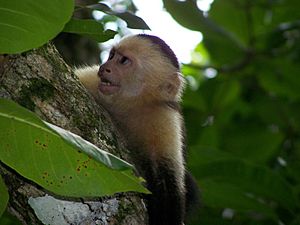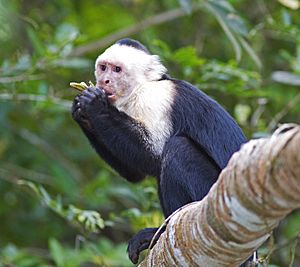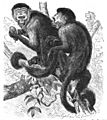White-headed capuchin facts for kids
Quick facts for kids White-headed capuchin |
|
|---|---|
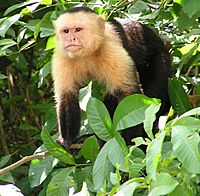 |
|
| Conservation status | |
| Scientific classification | |
| Kingdom: | |
| Phylum: | |
| Class: | |
| Order: | |
| Family: |
Cebidae
|
| Genus: |
Cebus
|
| Species: |
C. capucinus
|
| Binomial name | |
| Cebus capucinus (Linnaeus, 1758)
|
|
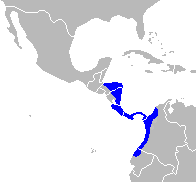 |
|
| Distribution of Cebus capucinus | |
| Synonyms | |
|
|
The white-headed capuchin (Cebus capucinus) is a medium-sized New World monkey. It belongs to the family Cebidae. People also call it the white-faced capuchin or white-throated capuchin. These monkeys live in the forests of Central America. You can also find them in the very northwestern part of South America.
White-headed capuchins are important for rain forests. They help spread seeds and pollen from plants. This helps new plants grow. These monkeys are very smart. They have even been trained to help people who cannot move their legs (called paraplegic people). They have also appeared in movies and TV shows.
This monkey is mostly black. It has a pink face and white fur on its front. It can weigh up to 3.9 kg (8.6 lb). It has a special tail that can grab things. This prehensile tail helps the monkey hold onto branches. In the wild, they eat many different foods. These include fruits, plants, insects, and small animals. They live in groups called troops. A troop can have more than 20 monkeys. They are known for using tools. They can live for over 54 years.
Contents
- About the White-Headed Capuchin
- What White-Headed Capuchins Look Like
- Monkey Behavior and Social Life
- Interactions with Other Animals
- What White-Headed Capuchins Eat
- Smart Monkeys and Tool Use
- Communication Among Capuchins
- Reproduction and Life Cycle
- Where White-Headed Capuchins Live
- Images for kids
About the White-Headed Capuchin
The white-headed capuchin was first described by Carl Linnaeus in the 1700s. It is part of the Cebidae family. This family includes other New World monkeys like squirrel monkeys and marmosets. It belongs to the Cebus group of monkeys. This group also includes the white-fronted capuchin.
Some scientists believe there are three types (subspecies) of white-headed capuchins:
- C. c. capucinus: Found in Ecuador, Colombia, and eastern Panama.
- C. c. imitator: Lives in most of Nicaragua, Costa Rica, and western Panama.
- C. c. limitaneus: Found in Honduras and northern Nicaragua.
However, other scientists do not think these subspecies are different enough.
What White-Headed Capuchins Look Like
Like other Cebus monkeys, the white-headed capuchin is named after Capuchin friars. Their white fur looks like the hoods (cowls) worn by these friars.
These monkeys have mostly black fur. They have white or yellow fur on their neck, throat, chest, shoulders, and upper arms. Their face is usually pink or a creamy white color. Sometimes, their face has dark marks. They also have a patch of black fur on top of their head.
Adult monkeys can be between 335 and 453 mm (13.2 and 17.8 in) long, not counting their tail. They can weigh up to 3.9 kg (8.6 lb). Their tail is longer than their body. It can be as long as 551 mm (21.7 in). Male monkeys are about 27% larger than females. The brain of a white-headed capuchin weighs about 79.2 g (2.79 oz). This is larger than some other big monkey brains.
Monkey Behavior and Social Life
White-headed capuchins are active during the day (they are diurnal). They mostly live in trees (they are arboreal). However, they do come down to the ground more often than many other monkeys. They usually move by walking on all four limbs.
They live in groups called troops. A troop can have up to 40 monkeys. Females usually stay with their family members for their whole lives. Males move to new groups several times. They usually move for the first time between 20 months and 11 years old. Males sometimes move alone, but often they move with other male relatives.
In a group, the main male (alpha male) often stays in charge for a long time. This means he is the father of most of the babies. However, alpha males usually do not have babies with their own daughters. Instead, other male allies in the group might mate with the alpha male's daughters.
Female monkeys often spend time with and help their female relatives. They also groom each other (clean each other's fur). Females tend to groom and spend time with other females who are close to them in the group's pecking order. Males are usually dominant over females. Male monkeys often fight with each other. They cooperate to defend their group from predators and other male monkeys.
Interactions with Other Animals
White-headed capuchins sometimes meet other monkey species in their habitat. They might travel with Geoffroy's Spider Monkeys. They even groom them sometimes. But they can also have aggressive fights with spider monkeys. They rarely interact with mantled howler monkeys. Sometimes, young capuchins and howlers play together.
Unlike some South American capuchins, white-headed capuchins rarely spend time with Central American squirrel monkeys. This is because their food sources are different. Also, there is less benefit for squirrel monkeys to hang out with capuchins in Central America.
Other animals are attracted to white-headed capuchins. White-lipped peccaries and common agoutis follow them. They look for fruit that the capuchins drop. Several bird species also follow capuchins to find food. These include the double-toothed kite and the white hawk.
What White-Headed Capuchins Eat
The white-headed capuchin is an omnivore. This means it eats both plants and animals. Its main foods are fruit and insects. They look for food everywhere in the forest, even on the ground. They peel bark off trees, search through leaves, break dead branches, and roll over rocks. They even use stones to crack open hard fruits. Their prehensile tail helps them hold on while they look for food under branches.
Fruit can make up more than half of their diet. In one study, they ate 95 different types of fruit. They love figs, mangos, and bean-like fruits. They usually only eat ripe fruit. They smell, taste, and poke the fruit to check if it's ready. They usually eat only the soft part and juice, spitting out seeds and fibers. They also eat flowers, young leaves, and seeds. They drink water from bromeliad plants.
They eat many insects. These include beetle larvae, caterpillars, ants, and wasps. They also eat bigger prey. This can be birds, bird eggs, frogs, lizards, crabs, and small mammals. Some groups of capuchins in Guanacaste, Costa Rica, are known for hunting squirrels and baby coatis. The amount of meat they eat can change between different groups.
Their diet also changes between the rainy and dry seasons. During the dry season, fruits are harder to find. So, they eat more insects and small animals. Water can also be hard to find in the dry season. Capuchins like to drink every day. So, groups might compete for water holes that are left.
Smart Monkeys and Tool Use
Capuchins are considered some of the smartest New World monkeys. Scientists study their behavior and intelligence a lot. Their intelligence helps them find food that might be hard to get. In one study, capuchins were among the ten most intelligent primates.
White-headed capuchins rub parts of certain plants on their fur. These plants include citrus fruits and vines. They also use ants and millipedes this way. Scientists are not sure why they do this. It might help keep away parasites like ticks and insects. It might also be like a medicine to fight germs or swelling. Or it could be a way to leave their scent.
These monkeys use tools in other ways too. They have been seen hitting snakes with sticks to protect themselves. In zoos, they use tools to get food or defend themselves. Some groups use trees or hard surfaces like anvils to crack open mollusks. They also use sticks to explore openings.
White-headed capuchins use tools, but not as often as some other capuchin species. Male capuchins tend to use tools more than females. Scientists think animals learn to use tools when food is hard to get and there are not many predators. This seems to be true for different groups of white-headed capuchins.
Because they are so smart and can use tools, white-headed capuchins can be trained to help paraplegic people. Other types of capuchin monkeys are also trained for this. White-headed capuchins have also been trained for TV and movies. For example, Marcel from the TV show Friends was a capuchin. They were also traditionally used by organ grinders.
Communication Among Capuchins
White-headed capuchins are noisy monkeys. They use loud calls like barks and coughs to warn others about danger. Softer calls, like squeals, are used for close talks. They have different calls for different threats. For example, a call for a threat from the ground is different from a call for a threat from a bird.
Their facial expressions and scent are also important for communication. They sometimes rub urine on their feet. This is called "urine washing". Scientists are not sure why they do this. It might be a way to send scent signals to other monkeys.
Reproduction and Life Cycle
White-headed capuchins have a mating system where one male can mate with many females (this is called polygamy). The main male in the group usually fathers most of the babies. He is more likely to mate when the female is most ready to have babies. It is rare for New World monkeys, but dominant males usually do not mate with their own daughters in the group.
A female monkey is pregnant for 5 to 6 months. Usually, one baby is born. Sometimes, twins can be born. Most babies are born during the dry season, from December to April. The mother carries the baby on her back for about 6 weeks. After 4 to 5 weeks, the baby can get off its mother's back for a short time. At 3 months old, it can move around by itself.
Babies stop drinking milk from their mother between 6 and 12 months. When the mother rests, the babies spend most of their time looking for food or playing. They can do this alone or with other babies. Other monkeys in the group, both males and females, often help care for the baby. This is called alloparenting.
Like other capuchin monkeys, white-headed capuchins grow up slowly. They can have babies when they are 3 years old. On average, females have their first baby at 7 years old. They then have a baby about every 26 months. Males are ready to have babies at 10 years old. White-headed capuchins live a long time. The longest recorded life span in a zoo was over 54 years.
Where White-Headed Capuchins Live
The white-headed capuchin lives in Central America and a small part of South America. In Central America, you can find them in Honduras, Nicaragua, Costa Rica, and Panama. There have been some sightings in eastern Guatemala and southern Belize, but these are not fully confirmed. In South America, they live in the very northwestern part. This area is between the Pacific Ocean and the Andes Mountains in Colombia and Ecuador.
They are often seen in national parks in Central America. These include Manuel Antonio National Park and Corcovado National Park. They are very common in Costa Rica and Panama. However, they have been removed from much of Honduras and Nicaragua. Many capuchins from Honduras were moved to Roatán island. Many from Nicaragua were moved to Ometepe island.
These monkeys live in many different types of forests. This includes evergreen and deciduous forests. They also live in dry and moist forests, and mangrove and montane forests. They seem to prefer older, untouched forests or forests that have regrown well.
Images for kids






